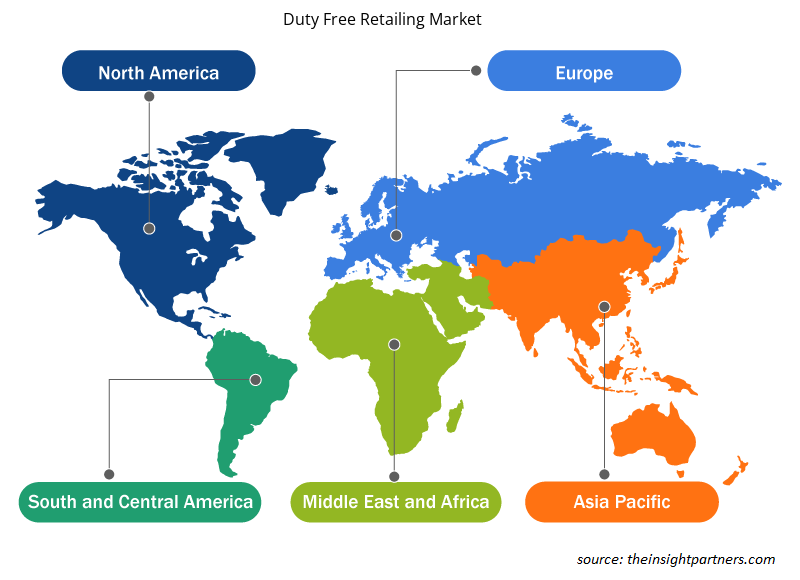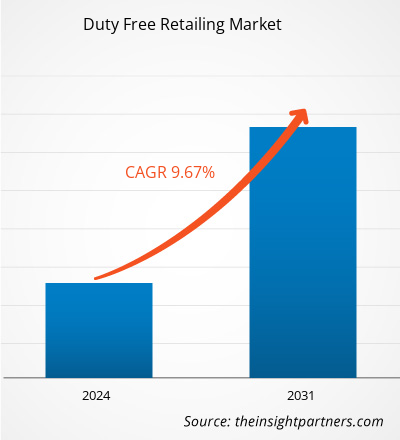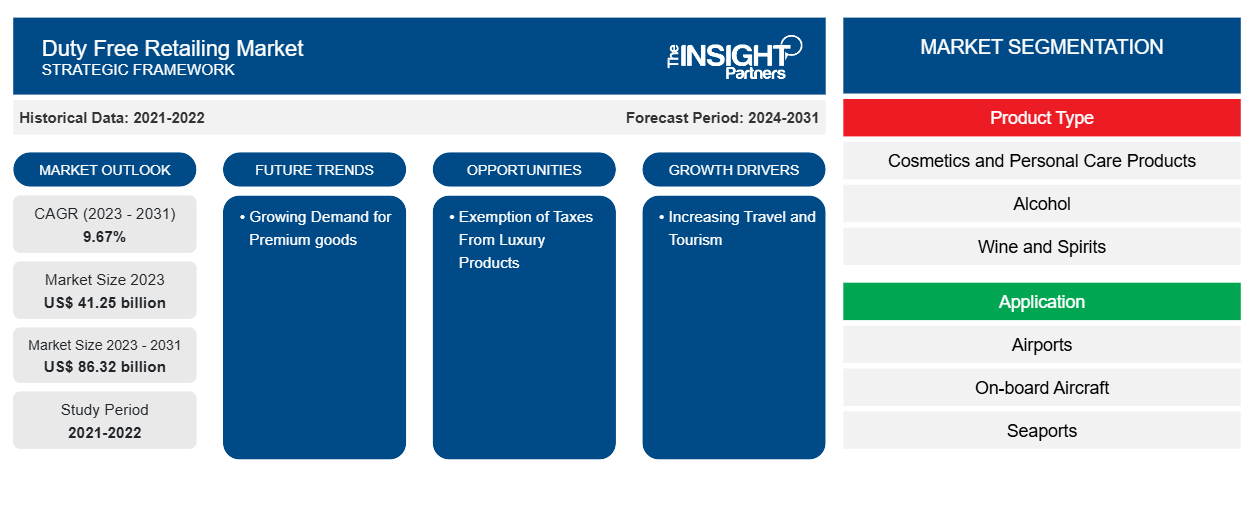면세점 시장 규모는 2023년 412억 5천만 달러에서 2031년 863억 2천만 달러로 성장할 것으로 전망된다. 면세점 시장은 2023~2031년 연평균 성장률 9.67%를 기록할 것으로 예상된다. 고급 제품과 원스톱 쇼핑의 퇴색이 심화되고 있다.
면세점 시장 분석
여행 및 관광 산업에 대한 투자와 개발이 확대되고, 호텔 및 인프라 등의 부문과 정부 지원이 통합되어 여행 및 관광 산업이 강화되면서 면세점 시장이 성장하게 되었습니다.
면세점 시장 개요
면세점이란 특정 국가세와 지방세를 면제받는 상품이 있는 매장을 말합니다. 이 면세는 일반 소매점에 비해 가격을 낮춥니다. 면세점은 여행객이 술, 향수, 담배, 화장품, 전자제품 등 다양한 제품에서 비용을 절감할 수 있는 기회를 제공합니다. 특히 고가의 사치품의 경우 절감 효과가 상당할 수 있습니다. 이러한 면세점은 국제 공항 터미널 내에 전략적으로 위치하여 다른 나라에서 출국하거나 도착하는 여행객이 쉽게 이용할 수 있습니다. 따라서 여행객이 여행 중에 필요한 품목을 쇼핑하거나 친구 및 가족을 위한 기념품과 선물을 사야 하는 경우 이러한 면세점에서 쉽게 구매할 수 있습니다.
귀하의 요구 사항에 맞게 이 보고서를 사용자 정의하세요
이 보고서의 일부 또는 국가 수준 분석, Excel 데이터 팩을 포함하여 모든 보고서에 대한 사용자 정의를 무료로 받을 수 있으며 신생 기업 및 대학을 위한 훌륭한 혜택과 할인 혜택을 이용할 수 있습니다.
-
이 보고서의 주요 시장 동향을 알아보세요.이 무료 샘플에는 시장 동향부터 추정 및 예측까지 다양한 데이터 분석이 포함됩니다.
면세점 소매 시장 동인 및 기회
사치품 세금 면제로 시장 활성화
면세품은 소비자가 면세 가격으로 고급품과 고가품을 구매할 수 있게 해줍니다. 바쁜 라이프스타일을 가진 소비자는 원스톱 쇼핑을 선호하며, 이러한 면세 소매는 더 나은 고급품을 쇼핑하는 데 도움이 됩니다. 향수, 시계, 시가, 고급 알코올, 패션 주얼리 등과 같은 고급품은 저렴한 가격으로 면세점에서 가장 매력적인 품목으로 소비자를 끌어들입니다. 게다가 다양한 국가에서 면세 고급품 매장을 오픈하고 있습니다. 예를 들어, 2021년 11월, 면세 고급품 매장인 루이비통이 하이난의 고급 섬 허브에 문을 열었습니다. 따라서 면세 고급품에 대한 이러한 성향은 면세 소매 시장의 성장을 촉진합니다.
여행 및 관광 증가
올해의 첫 번째 유엔 세계무역기구(UNWTO) 세계 관광 바로미터에 따르면, 국제 관광은 2023년을 88%로 마감했으며, 약 13억 명의 국제 관광객이 방문했습니다. 최신 UNWTO 세계 관광 바로미터는 2023년 이 부문의 실적에 대한 전체적인 개요를 제공하며, 글로벌 지역, 하위 지역 및 목적지별 회복을 추적합니다. 예비 추정에 따르면, 국제 관광 수입은 2023년에 1조 4,000억 달러에 도달했습니다. 또한, 비자 간소화 및 향상된 항공 수용 능력으로 인해 2024년 중국인 출국 및 입국 관광이 가속화될 것으로 추산됩니다. 중국은 2024년 11월 30일까지 1년 동안 프랑스, 이탈리아, 독일, 네덜란드, 스페인, 말레이시아 시민을 대상으로 비자 면제 여행을 신청하고 있습니다. 유럽은 2024년에도 다시 결과를 낼 것으로 예상됩니다. 3월에 루마니아와 불가리아는 솅겐 자유 이동 지역에 가입했고, 파리는 2024년 7월과 8월에 하계 올림픽을 개최할 예정입니다. 여행과 관광을 늘리는 이러한 호의는 국제 여행을 증가시켜 면세점 시장 성장의 기회를 창출할 것입니다.
면세점 소매 시장 보고서 세분화 분석
면세 소매 시장 분석에 기여한 주요 세그먼트는 제품 유형과 응용 분야입니다.
- 면세 소매 시장은 제품 유형에 따라 화장품 및 개인 관리 제품, 알코올, 와인 및 주류, 담배 및 시가, 패션, 과자 및 식품, 기타로 구분됩니다.
- 면세점 시장은 응용 프로그램을 기준으로 공항, 항공기 내, 항구 및 기타로 구분됩니다.
지역별 면세점 시장 점유율 분석
면세점 시장 보고서의 지리적 범위는 주로 북미, 아시아 태평양, 유럽, 중동 및 아프리카, 남미/남중부 아메리카의 5개 지역으로 나뉩니다. 증가하는 여행 및 관광과 공항 인프라의 성장에 따른 글로벌 면세점. 2023년 8월, Airports Council International(ACI) World는 2022년에서 2040년 사이에 승객 교통량이 연평균 5.8% 증가할 것으로 예측합니다. 2040년까지 매년 190억 명 이상의 승객이 세계 공항을 이용할 것입니다. 2023년 11월, Airport Council International은 아시아 태평양 지역이 항공에 상당한 잠재력이 있다고 보고했습니다. 전 세계적으로 계획된 300개 공항의 57%가 이 지역에 들어설 예정이기 때문입니다. 따라서 공항과 승객 교통량의 이러한 성장은 면세점 시장 성장에 수익성 있는 기회를 만들어냅니다.
면세점 시장 지역별 통찰력
Insight Partners의 분석가들은 예측 기간 동안 면세점 시장에 영향을 미치는 지역적 추세와 요인을 철저히 설명했습니다. 이 섹션에서는 북미, 유럽, 아시아 태평양, 중동 및 아프리카, 남미 및 중미의 면세점 시장 세그먼트와 지리적 분포도 논의합니다.

- 면세점 시장의 지역별 특정 데이터 얻기
면세점 시장 보고서 범위
| 보고서 속성 | 세부 |
|---|---|
| 2023년 시장 규모 | 412억 5천만 달러 |
| 2031년까지 시장 규모 | 863억 2천만 달러 |
| 글로벌 CAGR (2023-2031) | 9.67% |
| 역사적 데이터 | 2021-2022 |
| 예측 기간 | 2024-2031 |
| 다루는 세그먼트 |
제품 유형별
|
| 포함된 지역 및 국가 |
북아메리카
|
| 시장 선도 기업 및 주요 회사 프로필 |
|
면세점 소매 시장 참여자 밀도: 비즈니스 역학에 미치는 영향 이해
면세점 시장은 소비자 선호도의 변화, 기술 발전, 제품의 이점에 대한 인식 증가와 같은 요인으로 인해 최종 사용자 수요가 증가함에 따라 빠르게 성장하고 있습니다. 수요가 증가함에 따라 기업은 제품을 확장하고, 소비자의 요구를 충족하기 위해 혁신하고, 새로운 트렌드를 활용하여 시장 성장을 더욱 촉진하고 있습니다.
시장 참여자 밀도는 특정 시장이나 산업 내에서 운영되는 회사나 기업의 분포를 말합니다. 주어진 시장 공간에 얼마나 많은 경쟁자(시장 참여자)가 존재하는지 그 규모나 전체 시장 가치에 비해 나타냅니다.
면세점 시장에서 운영되는 주요 회사는 다음과 같습니다.
- 에어리안타인터내셔널(ARI)
- 중국면세그룹유한공사
- 두바이 듀티프리
- 듀티프리 아메리카스
- 게브르 하이네만
- 킹파워인터내셔널그룹
면책 조항 : 위에 나열된 회사는 어떤 특별한 순서에 따라 순위가 매겨지지 않았습니다.

- 면세점 시장 주요 주요 업체 개요를 알아보세요
면세점 시장 뉴스 및 최근 동향
면세 소매 시장은 1차 및 2차 조사 이후의 정성적, 정량적 데이터를 수집하여 평가합니다. 여기에는 중요한 기업 간행물, 협회 데이터 및 데이터베이스가 포함됩니다. 다음은 시장의 개발 목록입니다.
- 2024년 3월, Mumbai Travel Retail Private Limited(MTRPL)는 OSPREE로 리브랜딩을 발표했습니다. 새로운 브랜드 아이덴티티인 'Ospree'는 Mumbai, Amritsar, Lucknow, Thiruvananthapuram, Jaipur, Ahmedabad, Mangalore를 포함한 모든 면세점 홀딩을 통합하려는 MTRPL의 전략입니다.
(출처: Mumbai Travel Retail Private Limited, 보도자료, 2024)
- 2024년 1월, Mumbai Duty Free는 차트라파티 시바지 마하라즈 국제공항 출발장에 Nappa Dori 매장을 오픈한다고 발표하면서 이 브랜드가 여행 소매 부문에 진출한다는 것을 알렸습니다. 가죽과 실을 의미하는 Nappa Dori는 수제 가죽 제품과 액세서리로 유명한 인도 출신 브랜드입니다.
(출처: Mumbai Duty Free, 보도자료, 2024)
면세 소매 시장 보고서 범위 및 제공물
"면세점 시장 규모 및 예측(2021-2031)" 보고서는 아래 영역을 포괄하는 시장에 대한 자세한 분석을 제공합니다.
- 범위에 포함된 모든 주요 시장 세그먼트에 대한 글로벌, 지역 및 국가 수준의 시장 규모 및 예측
- 동인, 제약 및 주요 기회와 같은 시장 역학
- 주요 미래 트렌드
- 자세한 PEST/포터의 5가지 힘과 SWOT 분석
- 주요 시장 동향, 주요 업체, 규정 및 최근 시장 동향을 포괄하는 글로벌 및 지역 시장 분석
- 시장 집중도, 히트맵 분석, 유명 기업 및 최근 개발 사항을 포함하는 산업 환경 및 경쟁 분석
- 자세한 회사 프로필
- 과거 분석(2년), 기준 연도, CAGR을 포함한 예측(7년)
- PEST 및 SWOT 분석
- 시장 규모 가치/거래량 - 글로벌, 지역, 국가
- 산업 및 경쟁 환경
- Excel 데이터세트
최근 보고서
사용 후기
구매 이유
- 정보에 기반한 의사 결정
- 시장 역학 이해
- 경쟁 분석
- 고객 인사이트
- 시장 예측
- 위험 완화
- 전략 기획
- 투자 타당성 분석
- 신흥 시장 파악
- 마케팅 전략 강화
- 운영 효율성 향상
- 규제 동향에 발맞춰 대응























 무료 샘플 받기 - 면세 소매 시장
무료 샘플 받기 - 면세 소매 시장